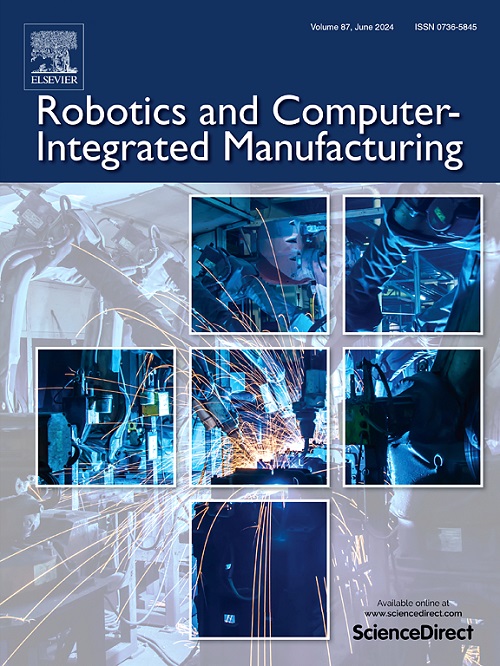Digital-twin-assisted multi-stage machining of thin-wall structures using interchangeable robotic and human-assisted automation
IF 11.4
1区 计算机科学
Q1 COMPUTER SCIENCE, INTERDISCIPLINARY APPLICATIONS
引用次数: 0
Abstract
Interconnected intelligent systems in multi-stage smart machining environments are an advancing area of research, demonstrating many real-life opportunities that can benefit from the development and integration of cyber-physical systems into machining habitats, while different automation levels in industrial manufacturing sites call for flexibility of core strategies towards smart machining ecosystems. This article introduces a versatile and smart multi-stage machining environment for the controlled clamping and machining of low-rigidity structures in an interconnected cyber-physical factory. This is exemplified by a deformation-prone thin-wall workpiece, which undergoes controlled clamping, enabled by interchangeable robotic automation and automation via human-cyber-physical systems, as well as digital-twin-assisted corrective machining enabled by the swift estimation of workpiece deformations and multi-stage communication between machining habitats. The underlying digital twin presents a fast, lightweight simulation approach, based on a mass-spring-lattice model, allowing information flow from and to systems, which is utilized by the CNC machine as well as the interchangeable robot- and human-in-the-loop clamping enablers. By employing this controlled clamping approach workpiece deformations are aimed to be minimized. At the same time, a desired total clamping force is achieved in order to perform subsequent digital-twin-assisted machining corrections to reduce deformation-caused flatness errors. Ultimately, this article presents an intelligent multi-stage machining scenario where digital-twin enabled information moves along with thin-wall structures and branches out for knowledge-based control and corrections to robots, humans and CNC machines respectively, showcasing a real-life example for versatile, information-driven smart machining ecosystems.
使用可互换的机器人和人工辅助自动化的薄壁结构的数字双辅助多级加工
多阶段智能加工环境中的互联智能系统是一个前沿研究领域,展示了许多现实生活中的机会,可以从网络物理系统的开发和集成到加工栖息地中受益,而工业制造场所的不同自动化水平要求智能加工生态系统的核心战略的灵活性。本文介绍了一种通用的智能多级加工环境,用于互联网络物理工厂中低刚度结构的控制夹紧和加工。以易变形薄壁工件为例,通过可互换的机器人自动化和人-网络-物理系统自动化实现控制夹紧,以及通过工件变形的快速估计和加工栖息地之间的多阶段通信实现数字孪生辅助校正加工。基于质量-弹簧-晶格模型的底层数字孪生提出了一种快速、轻量级的仿真方法,允许信息流从系统到系统,这被CNC机床以及可互换的机器人和人在环夹紧使能器所利用。通过采用这种控制夹紧方法,工件变形的目标是最小化。同时,实现了所需的总夹紧力,以便执行随后的数字双辅助加工修正,以减少变形引起的平面度误差。最后,本文展示了一个智能多阶段加工场景,其中数字孪生支持的信息随着薄壁结构移动,并分别向机器人、人类和数控机床分支进行基于知识的控制和校正,展示了一个多用途、信息驱动的智能加工生态系统的现实例子。
本文章由计算机程序翻译,如有差异,请以英文原文为准。
求助全文
约1分钟内获得全文
求助全文
来源期刊
CiteScore
24.10
自引率
13.50%
发文量
160
审稿时长
50 days
期刊介绍:
The journal, Robotics and Computer-Integrated Manufacturing, focuses on sharing research applications that contribute to the development of new or enhanced robotics, manufacturing technologies, and innovative manufacturing strategies that are relevant to industry. Papers that combine theory and experimental validation are preferred, while review papers on current robotics and manufacturing issues are also considered. However, papers on traditional machining processes, modeling and simulation, supply chain management, and resource optimization are generally not within the scope of the journal, as there are more appropriate journals for these topics. Similarly, papers that are overly theoretical or mathematical will be directed to other suitable journals. The journal welcomes original papers in areas such as industrial robotics, human-robot collaboration in manufacturing, cloud-based manufacturing, cyber-physical production systems, big data analytics in manufacturing, smart mechatronics, machine learning, adaptive and sustainable manufacturing, and other fields involving unique manufacturing technologies.

 求助内容:
求助内容: 应助结果提醒方式:
应助结果提醒方式:


